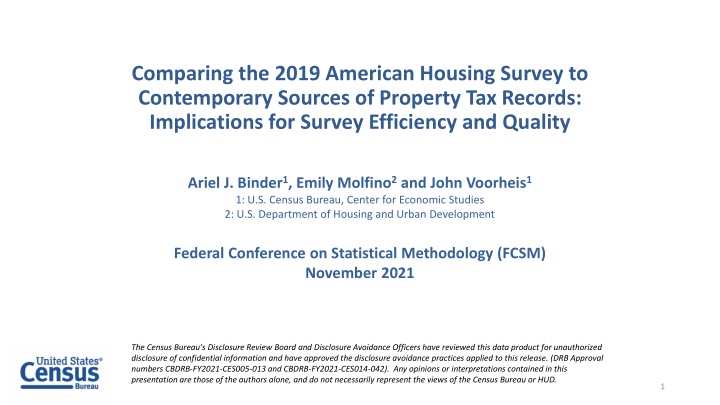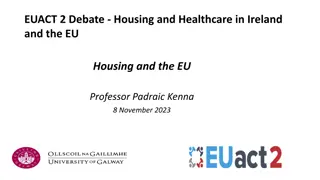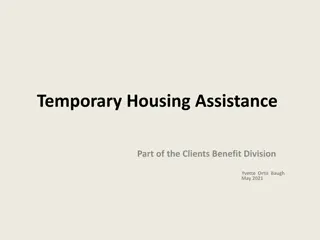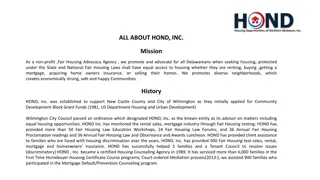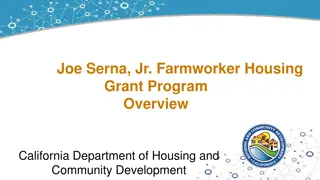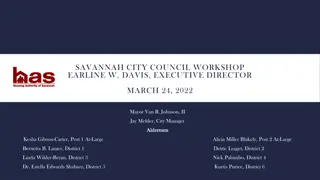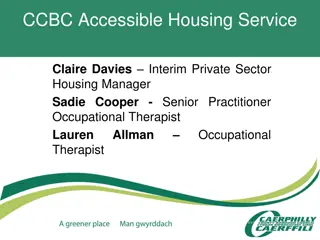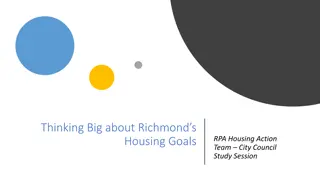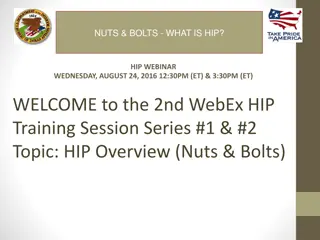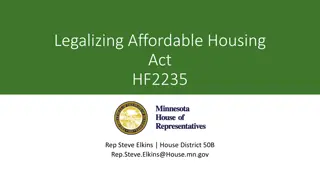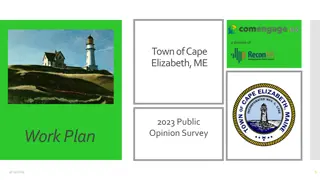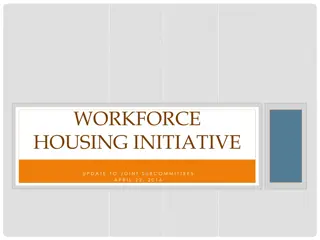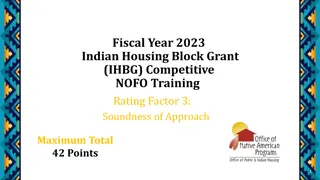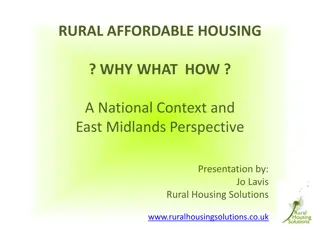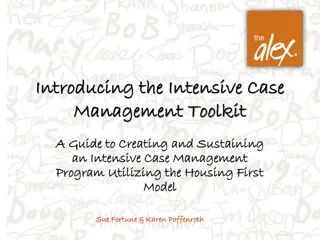Comparing 2019 American Housing Survey Efficiency
This study explores the implications of comparing the 2019 American Housing Survey to contemporary sources of property tax records, focusing on survey efficiency and data quality. Incorporating administrative records into household surveys and addressing declining response rates are also discussed, along with objectives to improve coverage rates. Various data sources and linking methods are examined to enhance the methodology for gathering property tax information.
Download Presentation

Please find below an Image/Link to download the presentation.
The content on the website is provided AS IS for your information and personal use only. It may not be sold, licensed, or shared on other websites without obtaining consent from the author.If you encounter any issues during the download, it is possible that the publisher has removed the file from their server.
You are allowed to download the files provided on this website for personal or commercial use, subject to the condition that they are used lawfully. All files are the property of their respective owners.
The content on the website is provided AS IS for your information and personal use only. It may not be sold, licensed, or shared on other websites without obtaining consent from the author.
E N D
Presentation Transcript
Comparing the 2019 American Housing Survey to Contemporary Sources of Property Tax Records: Implications for Survey Efficiency and Quality Ariel J. Binder1, Emily Molfino2 and John Voorheis1 1: U.S. Census Bureau, Center for Economic Studies 2: U.S. Department of Housing and Urban Development Federal Conference on Statistical Methodology (FCSM) November 2021 The Census Bureau's Disclosure Review Board and Disclosure Avoidance Officers have reviewed this data product for unauthorized disclosure of confidential information and have approved the disclosure avoidance practices applied to this release. (DRB Approval numbers CBDRB-FY2021-CES005-013 and CBDRB-FY2021-CES014-042). Any opinions or interpretations contained in this presentation are those of the authors alone, and do not necessarily represent the views of the Census Bureau or HUD. 1
Incorporating Administrative Records (Adrecs) into Household Surveys Adrecs can improve the efficiency of data collection. o In terms of dollars spent and respondent time to produce data of a given quality. o Examples: Sample Frame construction. Item Supplementation: filling in response with adrecs for all or subset of respondents, or pre-populating a write- in response. Adrecs can improve the quality of data collection. o Reducing error caused by respondents providing incorrect information ( rounding up of acreage). o Item Nonresponse: improving imputation models. o Unit Nonresponse: improving the adjustment of survey weights for nonresponse. AHS has used property tax data in Item Nonresponse for two questions since 2015. 2
Example: Declining Response Rates to CPS March CPS share individuals w/ imputed earnings Basic Monthly CPS Response Rate Source: Stephens and Unayama (2019), Figure 1 Source: Rothbaum and Bee (2021), Figure 1 Affects myriad other government surveys, including the American Housing Survey (AHS). Especially problematic if nonresponse is nonrandom. 3
Summary of Current Research Setting: o Census switched to using a different property tax source since AHS first rolled out its edit procedure. o Interest in expansion of methodology to more variables. Objectives: o How do coverage rates of AHS in property tax datadiffer: Across property tax data sources (S1,S2)? Across states? Across key variables? o How do rates of variable agreement differ across these dimensions? o Can we improve coverage rates by incorporating geographic as well as address information? combining the two sources? 4
Data Sources and Linking Data Sources: o 2019 AHS household file. o 2019 property tax assessment files from Source 1 (S1). o 2017 property tax assessment files from Source 2 (S2). o Note: property tax files contain parcels, different concept than addresses. AHS s main linking algorithm for S1 and S2: 1. Exact address text match. 2. No exact address match identities of 4 nearest property tax IDs based on lat/lon points. S1 contains new geographic shape file that traces boundaries of each parcel. Exploratory algorithm: 1. Exact geospatial match (i.e. AHS lat/lon point lies inside parcel shape). 2. Exact address text match. 3. No exact matches identities of 4 nearest property tax IDs based on lat/lon points. 5
List of Variables (for now) Variable Priority Year built high Lot size (acres) high Monthly property tax high Unit size (sqft) other Bedrooms other Bathrooms other Number of units in building other Stories in building other Garage presence and type other Basement presence and type other In a legal subdivision? other return 6
Coverage Rates of S1 and S2 in AHS S1 coverage rates S2 coverage rates National rate = 78% State min = 35% State med = 77% State max = 86% National rate = 75% State min = 30% State med = 76% State max = 88% Source: 2019 AHS combined with property tax records from 2019 (S1) and 2017 (S2) 7
Coverage Rate Differences Coverage rate differences National difference = 3% State min = -8% State med = 2% State max = 35% Source: 2019 AHS combined with property tax records from 2019 (S1) and 2017 (S2) 8
Calculating Agreement Rates Conditional agreement rate = share of observations with nonmissing adrec value where AHS and adrec have same value. Unconditional agreement rate = share of all AHS observations where AHS and adrec have same value. That is, conditional agreement rate = unconditional agreement rate / coverage rate. We report both conditional and unconditional agreement rates. Due to variance in coverage rates by state. 9
Average Unconditional Agreement Rates Source: 2019 AHS combined with property tax records from 2019 (S1) and 2017 (S2) 10
Average Conditional Agreement Rates (excl AK and ND) Source: 2019 AHS combined with property tax records from 2019 (S1) and 2017 (S2) 11
Improvement in S1 Coverage Rates from Incorporating Geospatial Info Exploratory algorithm: 1. Exact geospatial match (i.e. AHS lat/lon point lies inside parcel shape). 2. Exact address text match. Source: 2019 AHS combined with property tax records from 2019 (S1) and 2017 (S2) 12
Lack of Improvement in S1 Agreement Rates Source: 2019 AHS combined with property tax records from 2019 (S1) and 2017 (S2) 13
Can We Leverage Both Sources to Improve Agreement Rates? Agreement rate improvements are always < 15% relative to S1 agreement rate. Source: 2019 AHS combined with property tax records from 2019 (S1) and 2017 (S2) 14
Discussion and Future Work Replacing AHS responses with third-party property tax records would be challenging for some states, and for multi-unit apartment buildings. See Molfino s forthcoming whitepapers. For certain states and variables, full replacement and/or supplementation appear promising. o Especially for single-family homes. o Future work: build on existing Item Nonresponse routines (explained in Molfino s work), develop other exploratory Nonresponse or Supplementation routines. Geospatial info improves coverage but is slightly less accurate than address info. o Future work: match on address first, then geo info. Two sources do not seem much better than one on average. o Future work: but maybe for certain states or variables. 15
Incorporating Administrative Records into Household Surveys Sample Frames: National Teacher and Principal Survey, National Survey of Children s Health, and the National Sample Survey of Registered Nurses. Unit Nonresponse: Research on using Adrecs in the creation of survey weights (e.g., ACS and CPS). Item Nonresponse: Adrecs are utilized in nonresponse imputation on the SIPP. Item Supplementation: Multiple projects assessing item supplementation (e.g., acreage on ACS). 16
Coverage Rates Summary by Variable Source: 2019 AHS combined with property tax records from 2019 (S1) and 2017 (S2) 17
AHS-S1-S2 linkage: constructing agreement rates Numerical variables: o YRBUILT, LOTSIZE, UNITSIZE: used public-use categories. o PROTAXAMT: assigned agreement if within $100 (after topcoding at $8300). o BATHS: collapsed 7-13 category into 7 (no full bath). Links well to totbath_calc variable for S2. For S1, combined baths + 0.5*partial_baths info. In addition, baths info is often reported in decimal format (i.e. 100==1). If missing, assigned the value 7. o STORIES: S2: rounded the floors variable (and assigned 1 if 0). S1: same, plus handling of text (e.g. 1+ assigned to 1, 1.75+ assigned to 2). Character variables: o GARAGE, FOUNDTYPE, SUBDIV: assigned the code no if missing (4 for FOUNDTYPE). o GARAGE, FOUNDTYPE: detailed codings translated into AHS codings. o Crude process for FOUNDTYPE: only matched codes 1-4 (5-9 refer to mobile homes). 18
Agreement Rates Summary by Variable Source: 2019 AHS combined with property tax records from 2019 (S1) and 2017 (S2) 19
